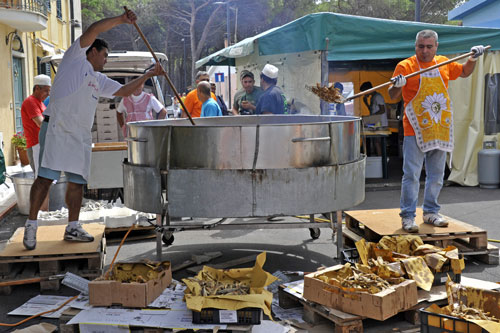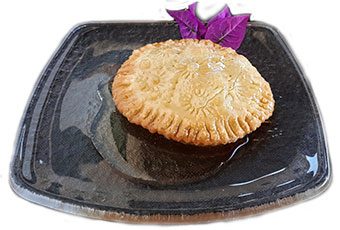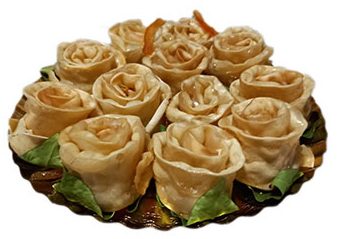Culinary specialities

Speciality sale at the market
Sardinia is a good place for gourmets to go on a journey of discovery, because many of the dishes on offer can only be found here. The names of the individual specialities may vary from region to region.
Almost all restaurants offer typical regional dishes and desserts.
You will also find a huge selection of typical Sardinian products and specialities at the markets that are held everywhere.
One of the best opportunities to taste typical Sardinian specialities is at the many festivals celebrated all over the island.
Pasta

Malloreddus
In many restaurants and of course also at Agriturismo, pasta is made in-house.
Typical are the ravioli filled with ricotta, but also the well-known pasta varieties such as spaghetti or tagliatelle, which are often freshly prepared by hand.
A frequently offered Sardinian speciality are malloreddus (also called gnocchetti sardi) – small shell-shaped pasta made of durum wheat semolina.
Also typical of Sardinia are fregola (fregula) – a pasta variety made of small balls that are not dried like other types of pasta, but roasted in the oven. This gives them a special aroma.
Meat

Porcheddu
Traditional meat dishes are spit-roasted pork, beef, lamb and goat. At festivals, the most common dish is porcheddu (suckling pig).
Air-dried ham from semi-wild pigs (prosciutto di montagna) and salami (salsiccia sarda) are often served together with cheese and olives.
Other meat specialities are steaks of beef, veal or horse meat (carne di cavallo). Dishes made from offal and brains are also often served.
During the hunting season in autumn, wild boar, wild rabbit and, unfortunately, many wild birds and songbirds are served.
Fish and seafood

Sagra del Pesce, Santa Lucia
Considering that Sardinia is an island, fish is served relatively rarely. This is due to Sardinian history, in which the Sardinians had little contact with the sea.
However, the more upmarket restaurants offer a good selection of mullet (muggine), prawns (scampi), langoustines (aragosta), mussels (cozze) and squid (sepia).
Cheese

Pecorino, Provoletta and Pane Carasau
Cheese is one of the most important staple foods in Sardinia.
It is made almost exclusively from sheep’s milk, resulting in a wide variety of types.
The best known is the pleasantly spicy Pecorino, which becomes so hard after a few months of storage that it is good for grating.
Even spicier is the smoked Fiore Sardo.
Mild varieties are Dolce Sardo and Ricotta cream cheese. The latter is also used as a filling for ravioli and pastries.
Provoletta is also very tasty. For this, a strand dough is made from cow’s milk, which is then hung up to mature in the shape of a pear.
A real speciality is Casu Marzu.
This pure Sardinian speciality is made from a Pecorino that is inoculated by flies with their eggs. Maggots hatch from these eggs and eat their way through the cheese, transforming its interior into a soft and very spicy mass with their excretions.
The cheese is broken open and the inside – in which thousands of maggots continue to crawl around – is eaten with bread and lots of red wine.
The maggots should be chewed well, as they are not immediately killed by gastric acid.
For a long time, the production and sale of this cheese was strictly forbidden. In the meantime, however, special sterile flies have been bred in the laboratory that allow controlled production and the cheese produced in this way may be sold again.
Bread

Sardinian Bread Art
Bread is also one of the most important staples in Sardinia and should not be missing from any table. There are countless variations and recipes. Artful figures are formed from bread dough, especially for religious festivals. (photo)
The most famous bread on the island is Pane Carasau, which the Italians also call “Carta Musica” (music paper).
It is a very thin, dry flatbread and keeps for a very long time – which used to be especially important for the wandering shepherds.
Pane Carasau is available everywhere in Sardinia. If you like it soft, hold the flatbreads briefly under water.
Seasoned with salt and olive oil, it is sold as Pane Guttiau.
For Pane Frattau, Pane Carasau is covered with boiling water or broth, followed by layers of tomato sauce, sheep cheese, and finally a fried egg – ready is a well-filling dish offered in many restaurants.
Pastries and sweets

These products, called dolci sardi, vary from region to region.
There are, among others, biscotti sardi, candelaus, casadinas (pardulas), caschettas, gattò, mustazzolus, pabassinas and pisiddu.
For almond pastries, there are bianchini, amaretti and sospiri.
At markets and festivals you will always find a wide range of different types of torrone. This mixture of honey, sugar and egg white is mixed with almonds, hazelnuts or walnuts in Sardinia.
 You should definitely try Seadas, which are offered in almost all restaurants as a dessert.
You should definitely try Seadas, which are offered in almost all restaurants as a dessert.
For these pastries, a kind of pasta dough is first prepared, which is cut into circles after a resting period.
The filling is made of ricotta or a young pecorino cheese, which is refined with grated orange or lemon peel.
This mixture is then spread over the dough circles, each covered with a second circle and pressed down at the edges.
The seadas are then placed in hot oil and deep-fried until golden brown and the cheese inside becomes liquid. They are then immediately doused with honey and served hot.
 For Origliette, a pastry is rolled out thinly, cut into strips, artfully shaped and then fried.
For Origliette, a pastry is rolled out thinly, cut into strips, artfully shaped and then fried.
Now the pastry is dipped in hot honey so that it is completely covered with a thin layer of honey.
Originally, Origliette were a typical carnival pastry.
In the meantime, they are also offered as a sweet dessert on many other occasions.
 Aranzada is a speciality originated in Nuoro.
Aranzada is a speciality originated in Nuoro.
For this, oranges are carefully peeled and the peel cut into thin strips. Only the orange part of the peel may be used.
These strips are first soaked in water for several days to neutralise the bitter taste.
After 3-5 days, the strips are dried, boiled in honey and roasted almond pieces are added.
When everything has cooled down, the loose mass is put into individual small paper cups.
In the past, aranzada was given to guests at weddings, especially in Barbagia and Baronia, but now you can buy the speciality all over the island.
Wine, beer and spirits

For wine lovers, the island offers a large selection of different varieties and growing regions.
You can really go on a voyage of discovery here, especially since the offer of Sardinian wines outside the island is very limited.
Almost half of the wines come from private producers, the growing areas are small – so there is no question of mass production.
The best-known varieties are the white Vermentino and the red Cannonau.
Vernaccia and Malvasia with an alcohol content of up to 18% can be described as dessert wines.
In general, most of the wines have quite a high alcohol content and there are varieties that are only grown in Sardinia.
When you walk around the individual wine shops, you will quickly notice how differently the shelves are stocked.
Many producers also offer open country wines at very reasonable prices.

Viticulture in the Gallura
Sardinia is divided into three different zones for viticulture:
In the north, grapes for the white Vermentino mainly thrive in Gallura.
In the centre of the island you will find varieties such as Cannonau, Alghero, Arborea, Vernaccia or Malvasia.
In the south, Nuragus, Campidano, Mandrolisai, Monica, Moscato and Nasco grow.
Filu ‘e Ferru (iron wire) is the name of the Sardinian variety of grappa. The name originated when a lot of bootleg was still distilled and the schnapps was then buried in the ground for fear of being inspected.
A wire was tied to the bottles and left to protrude a little from the ground, making it easier to find the hidden bottles.
The main liqueurs produced are Mirto – a herbal liqueur made from myrtle berries – and Limoncello (made from lime).
Ichnusa is the name of the Sardinian type of beer. It is a lager and is sold in shops mainly in 0.66 l bottles.
